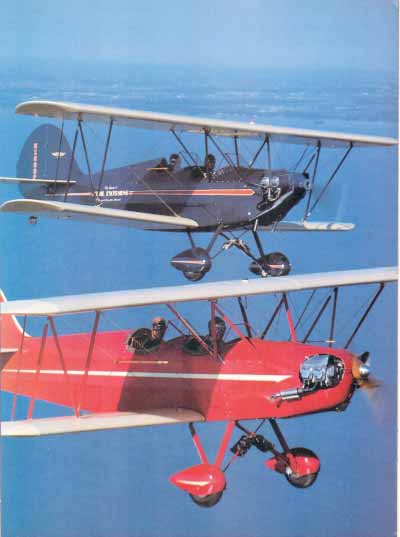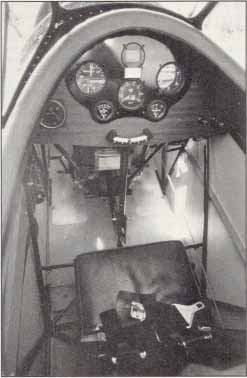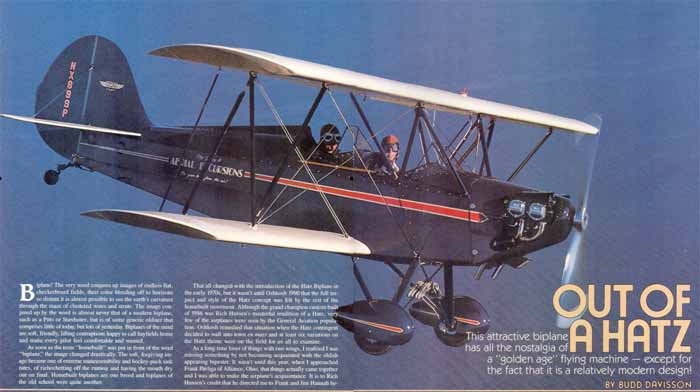Page Two
 |
Now THAT looks like
fun. Two funky biplanes going somewhere together. |
When John Hatz, the FBO at Merrill, Wisconsin,
decided to design and build an airplane, he had no intention of offering
the plane for others to build. The project sat around in his shop
from 1959, when it was started, to 1967, when he finished the plane.
Hatz just wanted a fun machine and it was Dudley Kelly, an engineer
from Versailles, Kentucky, who talked him into allowing him to
draw up a set of plans and offer them to the public so they might
discover the fun of the Hatz. Unfortunately, John Hatz was killed
in an auto accident last year, but not before nearly 500 sets of
plans were sold and approximately 40 aircraft took to the air.
Frank states he found the plans to be excellent although they do
allow for a certain amount of personal innovation, such as the way
in which he crafted his own throttle arrangement — pivoted
at the top, like an amphibian, rather than at the bottom. Frank did
it that way because that's the way they had done it on their Pietenpol.
As designed, the airplane is supposed to utilize engines from the 100
horse 0-200 Continental up to the 150 horse 0-320 Lycoming,
meaning there is an obvious wide variation in weights. The plan weight
is supposed to be 850 pounds, although Frank says he has seen them
run from 820 pounds to as high as nearly 1100 bloated pounds. As
with all small airplanes, weight is the enemy of performance and handling
and most Hatz drivers report they are happier with the smaller engines
and lighter weight.
When it came time for Frank to select an engine, he found the cheapest
available to be a 115 hp 0-235 Lycoming out of a Pitts project a
friend had purchased. This is probably still one of the cheapest available,
mainly because of all the C-152s that have bitten the dust. Frank's
engine, however, is out of a 1947 Piper Cruiser. Once again, proximity
and convenience played the major role in supplying parts for a homebuilt.
Even though Frank is running a much heavier engine than the 0-200,
careful building and material selection, such as using the Stits
covering and finishing process, kept the weight down to within 20 pounds of
design weight. It's always satisfying for a builder to come that
close to the designer's original weight goal since the vast majority of homebuilts
far exceed what the designer had in mind.
Initially, Frank pointed me at the airplane and said, "go fly,
and have a good time:' A two-place airplane, however, should al-ways
be shown in its worst light: When carrying that extra passenger.
This is especially important with homebuilts, since so many of them
are actually excellent single-place machines but change their personality
entirely when the option to carry that extra person is exercised.
Frank Sr. was volunteered to be the guinea pig passenger who sat
in front, while I saddled up in the back.
In walking around the airplane, it's obvious no concessions were
made to modern times. With the framed windshield and exposed cylinders,
Frank has done an excellent job of capturing the 1930s in a 1990
airframe.
 |
Can we say "simplicity" boys and girls? Visibility is excellent
in the air and on the ground considering the type. |
Climbing into the airplane was typical 1930s as
well. Wrapping a hand around the wires and then the centersection
hand hold was necessary to scramble over the gunwhales and down into
the cockpit. Frank has carried the nostalgia theme so evident on
the outside into the cockpit, where the polished mahogany instrument
panel worked with the rest of the cockpit layout to whisper lines
out of old black and white flying films. It was hard not to feel
like Noah Berry or Richard Arlen, as I pulled the helmet down and
fastened the chin strap.
After strapping in, I tested the controls and found the rudder to
be embedded in concrete with no movement available at all. I hadn't
noticed the tailwheel steering was direct, with no springs. Unless
the airplane was rolling, there was no way I was going to move the
rudder and the firmly attached tailwheel. I made a mental note to
expect quick acting steering and to limit my feet to exactly what
was needed and nothing more.
At first, wrapping my hand round the hanging throttle lever felt
a little strange but, since the actuating rod was attached to the
bottom end of the lever, it was very natural to rest a couple of
fingers on it and I didn't notice the situation even once after starting
the engine.
Turning the fuel lever by my right knee to the vertical "on" position
and hollering "off and closed;' I watched as Frank pulled the
Lyc through three or four blades before yelling "contact:' My
heels were firmly planted on the inward mounted heel brakes and I
flipped the mags to "both" as he swung the prop through.
This action was quickly followed by the sounds of a Lycoming happily
nibbling on the proper fuel/air mixture.
Since the tailwheel had no full swivel mode, I didn't know if it
would be possible to power up out of the grass parking spot and turn
90 degrees onto the taxiway. This question was answered immediately
as I put the left rudder down and the airplane smartly
executed a tight turn onto the taxiway centerline. Using the centerline
as a datum, I purposely made exaggerated "S" turns to get
a feel for the steering. As expected, I found it to be absolutely
immediate — whatever my feet asked the airplane to do, it did
instantaneously. Not many airplanes have such a direct steering mechanism,
so I paid special attention to how my feet felt and what my eyes
were seeing so I wouldn't be surprised on landing or takeoff by over
controlling.
I finished the rudimentary run-up and turned to look directly at
the temporary tower set up at Fond du Lac, reaching a hand over my
head to give them the thumbs-up. Just as quickly, they fired a green
light back at me and I taxied out on the centerline.
GO TO NEXT PAGE
|


